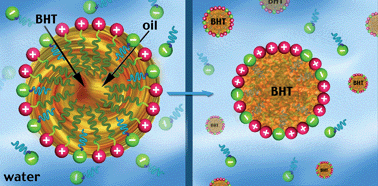Formation of solid organic nanoparticles from a volatile catanionic microemulsion
Abstract
A novel volatile microemulsion formed by the catanionic

* Corresponding authors
a Hebrew University of Jerusalem, Casali Institute of Applied Chemistry, Institute of Chemistry and Center for Nanotechnology, Jerusalem, Israel
b
Centro de Investigação em Química, Department of Chemistry and Biochemistry, Faculty of Science, University of Porto, Rua do Campo Alegre, no. 687, Porto, Portugal
E-mail:
efmarque@fc.up.pt
c Division of Physical Chemistry, Centre for Chemistry and Chemical Engineering, Lund University, P.O. Box 124, Lund, Sweden
A novel volatile microemulsion formed by the catanionic

 Please wait while we load your content...
Something went wrong. Try again?
Please wait while we load your content...
Something went wrong. Try again?
K. Margulis-Goshen, B. F. B. Silva, E. F. Marques and S. Magdassi, Soft Matter, 2011, 7, 9359 DOI: 10.1039/C1SM05637A
To request permission to reproduce material from this article, please go to the Copyright Clearance Center request page.
If you are an author contributing to an RSC publication, you do not need to request permission provided correct acknowledgement is given.
If you are the author of this article, you do not need to request permission to reproduce figures and diagrams provided correct acknowledgement is given. If you want to reproduce the whole article in a third-party publication (excluding your thesis/dissertation for which permission is not required) please go to the Copyright Clearance Center request page.
Read more about how to correctly acknowledge RSC content.
 Fetching data from CrossRef.
Fetching data from CrossRef.
This may take some time to load.
Loading related content
